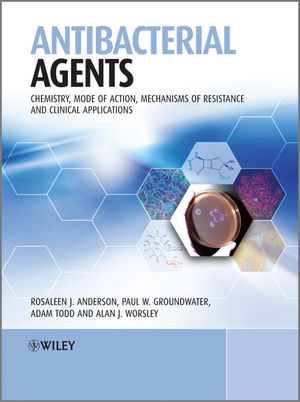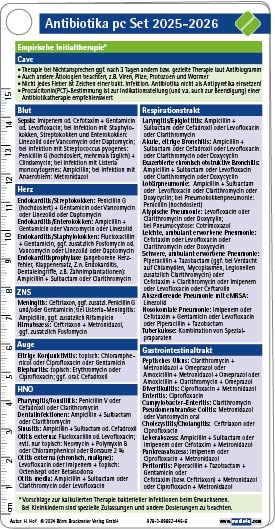
Antibacterial Agents
John Wiley & Sons Inc (Verlag)
978-0-470-97244-1 (ISBN)
- Titel ist leider vergriffen;
keine Neuauflage - Artikel merken
Antibacterial Agents is an essential guide to this important class of chemotherapeutic drugs. Compounds are organised according to their target, which helps the reader understand the mechanism of action of these drugs and how resistance can arise. The book uses an integrated “lab-to-clinic” approach which covers drug discovery, source or synthesis, mode of action, mechanisms of resistance, clinical aspects (including links to current guidelines, significant drug interactions, cautions and contraindications), prodrugs and future improvements.
Agents covered include:
agents targeting DNA - quinolone, rifamycin, and nitroimidazole antibacterial agents
agents targeting metabolic processes - sulfonamide antibacterial agents and trimethoprim
agents targeting protein synthesis - aminoglycoside, macrolide and tetracycline antibiotics, chloramphenicol, and oxazolidinones
agents targeting cell wall synthesis - β-Lactam and glycopeptide antibiotics, cycloserine, isonaizid, and daptomycin
Antibacterial Agents will find a place on the bookshelves of students of pharmacy, pharmacology, pharmaceutical sciences, drug design/discovery, and medicinal chemistry, and as a bench reference for pharmacists and pharmaceutical researchers in academia and industry.
Professor Rosaleen Anderson, Professor of Pharmaceutical Chemistry, Sunderland Pharmacy School, University of Sunderland, UK Professor Paul Groundwater, Professor of Medicinal Chemistry, Faculty of Pharmacy, The University of Sydney, Australia Dr Adam Todd, Senior Lecturer in Pharmacy Practice, Sunderland Pharmacy School, University of Sunderland, UK Dr Alan Worsley, Principal Lecturer in Pharmacy Practice, Sunderland Pharmacy School, University of Sunderland, UK
Preface xi SECTION 1 INTRODUCTION TO MICROORGANISMS AND ANTIBACTERIAL
CHEMOTHERAPY 1
1.1 Microorganisms 3
Key points 3
1.1.1 Classification 3
1.1.2 Structure 4
1.1.3 Bacterial detection and identification 17
1.1.4 Other than its mode of action, what factors determine the antibacterial activity of a drug? 25
1.1.5 Bacterial resistance 27
1.1.6 The ‘post-antibiotic age’? 29
References 31
Questions 33
SECTION 2 AGENTS TARGETING DNA 35
2.1 Quinolone antibacterial agents 37
Key points 37
2.1.1 Discovery 37
2.1.2 Synthesis 39
2.1.3 Bioavailability 41
2.1.4 Mode of action and selectivity 44
2.1.5 Bacterial resistance 45
2.1.6 Clinical applications 47
2.1.7 Adverse drug reactions 50
2.1.8 Drug interactions 55
2.1.9 Recent developments 56
References 60
2.2 Rifamycin antibacterial agents 63
Key points 63
2.2.1 Discovery 63
2.2.2 Synthesis 65
2.2.3 Bioavailability 68
2.2.4 Mode of action and selectivity 69
2.2.5 Bacterial resistance 71
2.2.6 Clinical applications 71
2.2.7 Adverse drug reactions 77
2.2.8 Drug interactions 78
2.2.9 Recent developments 81
References 81
2.3 Nitroimidazole antibacterial agents 85
Key points 85
2.3.1 Discovery 85
2.3.2 Synthesis 86
2.3.3 Bioavailability 86
2.3.4 Mode of action and selectivity 87
2.3.5 Mechanisms of resistance 89
2.3.6 Clinical applications 90
2.3.7 Adverse drug reactions and contraindications 94
2.3.8 Drug interactions 95
2.3.9 Recent developments 97
References 97
Questions 101
SECTION 3 AGENTS TARGETING METABOLIC PROCESSES 103
3.1 Sulfonamide antibacterial agents 105
Key points 105
3.1.1 Discovery 105
3.1.2 Synthesis 107
3.1.3 Bioavailability 108
3.1.4 Mode of action and selectivity 111
3.1.5 Bacterial resistance 114
3.1.6 Clinical applications 115
3.1.7 Adverse drug reactions 119
3.1.8 Drug interactions 122
3.1.9 Recent developments 123
References 124
3.2 Trimethoprim 127
Key points 127
3.2.1 Discovery 127
3.2.2 Synthesis 128
3.2.3 Bioavailability 130
3.2.4 Mode of action and selectivity 130
3.2.5 Bacterial resistance 136
3.2.6 Clinical applications 136
3.2.7 Adverse drug reactions 138
3.2.8 Drug interactions 138
3.2.9 Recent developments 139
References 140
Questions 145
SECTION 4 AGENTS TARGETING PROTEIN SYNTHESIS 147
4.1 Aminoglycoside antibiotics 149
Key points 149
4.1.1 Discovery 149
4.1.2 Synthesis 152
4.1.3 Bioavailability 156
4.1.4 Mode of action and selectivity 158
4.1.5 Bacterial resistance 160
4.1.6 Clinical applications 161
4.1.7 Adverse drug reactions 165
4.1.8 Drug interactions 167
4.1.9 Recent developments 168
References 168
4.2 Macrolide antibiotics 173
Key points 173
4.2.1 Discovery 173
4.2.2 Synthesis 175
4.2.3 Bioavailability 177
4.2.4 Mode of action and selectivity 180
4.2.5 Bacterial resistance 181
4.2.6 Clinical applications 182
4.2.7 Adverse drug reactions 187
4.2.8 Drug interactions 189
4.2.9 Recent developments 192
References 193
4.3 Tetracycline antibiotics 197
Key points 197
4.3.1 Discovery 197
4.3.2 Synthesis 200
4.3.3 Bioavailability (agwuh and macgowan, 2006) 205
4.3.4 Mode of action and selectivity 210
4.3.5 Bacterial resistance 213
4.3.6 Clinical applications 217
4.3.7 Adverse drug reactions 223
4.3.8 Drug interactions 224
4.3.9 Recent developments 224
References 225
4.4 Chloramphenicol 231
Key points 231
4.4.1 Discovery 231
4.4.2 Synthesis 231
4.4.3 Bioavailability 232
4.4.4 Mode of action and selectivity 235
4.4.5 Bacterial resistance 235
4.4.6 Clinical applications 236
4.4.7 Adverse drug reactions 238
4.4.8 Drug interactions 239
4.4.9 Recent developments 239
References 241
4.5 Oxazolidinones 243
Key points 243
4.5.1 Discovery 243
4.5.2 Synthesis 245
4.5.3 Bioavailability 247
4.5.4 Mode of action and selectivity 248
4.5.5 Bacterial resistance 249
4.5.6 Clinical applications 251
4.5.7 Adverse drug reactions 252
4.5.8 Drug interactions 253
4.5.9 Recent developments 254
References 254
Questions 259
SECTION 5 AGENTS TARGETING CELL-WALL SYNTHESIS 261
5.1 b-lactam antibiotics 263
Key points 263
5.1.1 Discovery 263
5.1.2 Synthesis 272
5.1.3 Bioavailability 277
5.1.4 Mode of action and selectivity 284
5.1.5 Bacterial resistance 285
5.1.6 Clinical applications 290
5.1.7 Adverse drug reactions 296
5.1.8 Drug interactions 298
5.1.9 Recent developments 300
References 301
5.2 Glycopeptide antibiotics 305
5.2.1 Discovery 305
5.2.2 Synthesis 305
5.2.3 Bioavailability 307
5.2.4 Mode of action and selectivity 308
5.2.5 Bacterial resistance 311
5.2.6 Clinical applications 313
5.2.7 Adverse drug reactions 314
5.2.8 Drug interactions 315
5.2.9 Recent developments 316
References 317
5.3 Cycloserine 319
Key points 319
5.3.1 Discovery 319
5.3.2 Synthesis 319
5.3.3 Bioavailability 320
5.3.4 Mode of action and selectivity 321
5.3.5 Bacterial resistance 323
5.3.6 Clinical applications 323
5.3.7 Adverse drug reactions and contraindications 325
5.3.8 Drug interactions 325
5.3.9 Recent developments 325
References 325
5.4 Isoniazid 327
Key points 327
5.4.1 Discovery 327
5.4.2 Synthesis 328
5.4.3 Bioavailability 329
5.4.4 Mode of action and selectivity 329
5.4.5 Bacterial resistance 330
5.4.6 Clinical applications 331
5.4.7 Adverse drug reactions and contraindications 333
5.4.8 Drug interactions 334
5.4.9 Recent developments 335
References 335
5.5 Daptomycin 339
Key points 339
5.5.1 Discovery 339
5.5.2 Synthesis 340
5.5.3 Bioavailability 341
5.5.4 Mode of action and selectivity 341
5.5.5 Bacterial resistance 343
5.5.6 Clinical applications 343
5.5.7 Adverse drug reactions and contraindications 344
5.5.8 Recent developments 345
References 346
Questions 349
Index 351
| Erscheint lt. Verlag | 23.7.2012 |
|---|---|
| Verlagsort | New York |
| Sprache | englisch |
| Maße | 196 x 254 mm |
| Gewicht | 989 g |
| Themenwelt | Medizin / Pharmazie ► Medizinische Fachgebiete ► Pharmakologie / Pharmakotherapie |
| Naturwissenschaften ► Biologie | |
| Naturwissenschaften ► Chemie | |
| Technik | |
| ISBN-10 | 0-470-97244-0 / 0470972440 |
| ISBN-13 | 978-0-470-97244-1 / 9780470972441 |
| Zustand | Neuware |
| Informationen gemäß Produktsicherheitsverordnung (GPSR) | |
| Haben Sie eine Frage zum Produkt? |
aus dem Bereich


